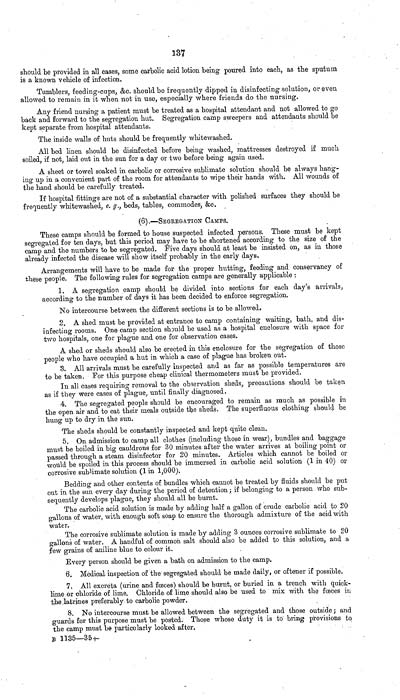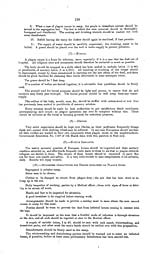Medicine - Disease > Account of plague administration in the Bombay Presidency from September 1896 till May 1897
(149) Page 137
Download files
Individual page:
Thumbnail gallery: Grid view | List view

137
should be provided in all cases, some carbolic acid lotion being poured into each, as the sputum
is a known vehicle of infection.
Tumblers, feeding-cups, &c. should be frequently dipped in disinfecting solution, or even
allowed to remain in it when not in use, especially where friends do the nursing.
Any friend nursing a patient must be treated as a hospital attendant and not allowed to go
back and forward to the segregation hut. Segregation camp sweepers and attendants should be
kept separate from hospital attendants.
The inside walls of huts should be frequently whitewashed.
All bed linen should be disinfected before being washed, mattresses destroyed if much
soiled, if not, laid out in the sun for a day or two before being again used.
A sheet or towel soaked in carbolic or corrosive sublimate solution should be always hang-
ing up in a convenient part of the room for attendants to wipe their hands with. All wounds of
the hand should be carefully treated.
If hospital fittings are not of a substantial character with polished surfaces they should be
frequently whitewashed, e. g., beds, tables, commodes, &c.
(6).-SEGREGATION CAMPS.
These camps should be formed to house suspected infected persons. These must be kept
segregated for ten days, but this period may have to be shortened according to the size of the camp and the numbers to be segregated. Five days should at least be insisted on, as in those
already infected the disease will show itself probably in the early days.
Arrangements will have to be made for the proper hutting, feeding and conservancy of
these people. The following rules for segregation camps are generally applicable:
1. A segregation camp should be divided into sections for each day's arrivals,
according to the number of days it has been decided to enforce segregation.
No intercourse between the different sections is to be allowed.
2. A shed must be provided at entrance to camp containing waiting, bath, and dis-
infecting rooms. One camp section should be used as a hospital enclosure with space for
two hospitals, one for plague and one for observation cases.
A shed or sheds should also be erected in this enclosure for the segregation of those
people who have occupied a hut in which a case of plague has broken out.
3. All arrivals must be carefully inspected and as far as possible temperatures are
to be taken. For this purpose cheap clinical thermometers must be provided.
In all cases requiring removal to the observation sheds, precautions should be taken
as if they were cases of plague, until finally diagnosed.
4. The segregated people should be encouraged to remain as much as possible in
the open air and to eat their meals outside the sheds. The superfluous clothing should be
hung up to dry in the sun.
The sheds should be constantly inspected and kept quite clean.
5. On admission to camp all clothes (including those in wear), bundles and baggage
must be boiled in big cauldrons for 30 minutes after the water arrives at boiling point or
passed through a steam disinfector for 20 minutes. Articles which cannot be boiled or
would be spoiled in this process should be immersed in carbolic acid solution (1 in 40) or
corrosive sublimate solution (1 in 1,000).
Bedding and other contents of bundles which cannot be treated by fluids should be put
out in the sun every day during the period of detention; if belonging to a person who sub-
sequently develops plague, they should all be burnt.
The carbolic acid solution is made by adding half a gallon of crude carbolic acid to 20
gallons of water, with enough soft soap to ensure the thorough admixture of the acid with
water.
The corrosive sublimate solution is made by adding 3 ounces corrosive sublimate to 20
gallons of water. A handful of common salt should also be added to this solution, and a
few grains of aniline blue to colour it.
Every person should be given a bath on admission to the camp.
6. Medical inspection of the segregated should be made daily, or oftener if possible.
7. All excreta (urine and fces) should be burnt, or buried in a trench with quick-
lime or chloride of lime. Chloride of lime should also be used to mix with the fces in
the latrines preferably to carbolic powder.
8. No intercourse must be allowed between the segregated and those outside; and
guards for this purpose must be posted. Those whose duty it is to bring provisions to
the camp must be particularly looked after.
B 1135-35\?\
should be provided in all cases, some carbolic acid lotion being poured into each, as the sputum
is a known vehicle of infection.
Tumblers, feeding-cups, &c. should be frequently dipped in disinfecting solution, or even
allowed to remain in it when not in use, especially where friends do the nursing.
Any friend nursing a patient must be treated as a hospital attendant and not allowed to go
back and forward to the segregation hut. Segregation camp sweepers and attendants should be
kept separate from hospital attendants.
The inside walls of huts should be frequently whitewashed.
All bed linen should be disinfected before being washed, mattresses destroyed if much
soiled, if not, laid out in the sun for a day or two before being again used.
A sheet or towel soaked in carbolic or corrosive sublimate solution should be always hang-
ing up in a convenient part of the room for attendants to wipe their hands with. All wounds of
the hand should be carefully treated.
If hospital fittings are not of a substantial character with polished surfaces they should be
frequently whitewashed, e. g., beds, tables, commodes, &c.
(6).-SEGREGATION CAMPS.
These camps should be formed to house suspected infected persons. These must be kept
segregated for ten days, but this period may have to be shortened according to the size of the camp and the numbers to be segregated. Five days should at least be insisted on, as in those
already infected the disease will show itself probably in the early days.
Arrangements will have to be made for the proper hutting, feeding and conservancy of
these people. The following rules for segregation camps are generally applicable:
1. A segregation camp should be divided into sections for each day's arrivals,
according to the number of days it has been decided to enforce segregation.
No intercourse between the different sections is to be allowed.
2. A shed must be provided at entrance to camp containing waiting, bath, and dis-
infecting rooms. One camp section should be used as a hospital enclosure with space for
two hospitals, one for plague and one for observation cases.
A shed or sheds should also be erected in this enclosure for the segregation of those
people who have occupied a hut in which a case of plague has broken out.
3. All arrivals must be carefully inspected and as far as possible temperatures are
to be taken. For this purpose cheap clinical thermometers must be provided.
In all cases requiring removal to the observation sheds, precautions should be taken
as if they were cases of plague, until finally diagnosed.
4. The segregated people should be encouraged to remain as much as possible in
the open air and to eat their meals outside the sheds. The superfluous clothing should be
hung up to dry in the sun.
The sheds should be constantly inspected and kept quite clean.
5. On admission to camp all clothes (including those in wear), bundles and baggage
must be boiled in big cauldrons for 30 minutes after the water arrives at boiling point or
passed through a steam disinfector for 20 minutes. Articles which cannot be boiled or
would be spoiled in this process should be immersed in carbolic acid solution (1 in 40) or
corrosive sublimate solution (1 in 1,000).
Bedding and other contents of bundles which cannot be treated by fluids should be put
out in the sun every day during the period of detention; if belonging to a person who sub-
sequently develops plague, they should all be burnt.
The carbolic acid solution is made by adding half a gallon of crude carbolic acid to 20
gallons of water, with enough soft soap to ensure the thorough admixture of the acid with
water.
The corrosive sublimate solution is made by adding 3 ounces corrosive sublimate to 20
gallons of water. A handful of common salt should also be added to this solution, and a
few grains of aniline blue to colour it.
Every person should be given a bath on admission to the camp.
6. Medical inspection of the segregated should be made daily, or oftener if possible.
7. All excreta (urine and fces) should be burnt, or buried in a trench with quick-
lime or chloride of lime. Chloride of lime should also be used to mix with the fces in
the latrines preferably to carbolic powder.
8. No intercourse must be allowed between the segregated and those outside; and
guards for this purpose must be posted. Those whose duty it is to bring provisions to
the camp must be particularly looked after.
B 1135-35\?\
Set display mode to: Large image | Zoom image | Transcription
Images and transcriptions on this page, including medium image downloads, may be used under the Creative Commons Attribution 4.0 International Licence unless otherwise stated. ![]()
| India Papers > Medicine - Disease > Account of plague administration in the Bombay Presidency from September 1896 till May 1897 > (149) Page 137 |
|---|
| Permanent URL | https://digital.nls.uk/74517308 |
|---|




